
Light Panel Guide 2024 Home of educational play


Light Panel Guide 2024 Home of educational play

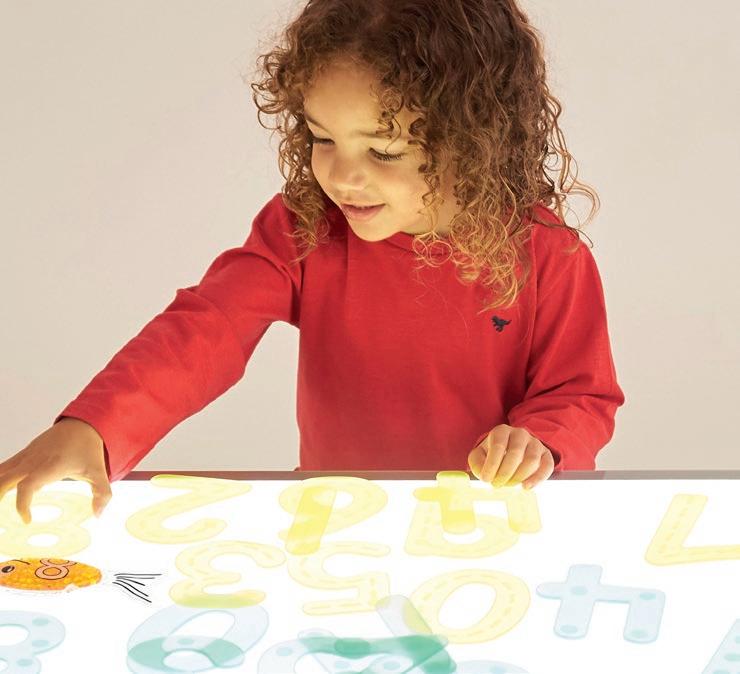
Product Code: 73046 Product Code: 73048


Product Code: 73022

Product Code: 73038
Product Code: 73054

Light Panel Covers (A3 & A2)
Product Code: 72046 & 72048
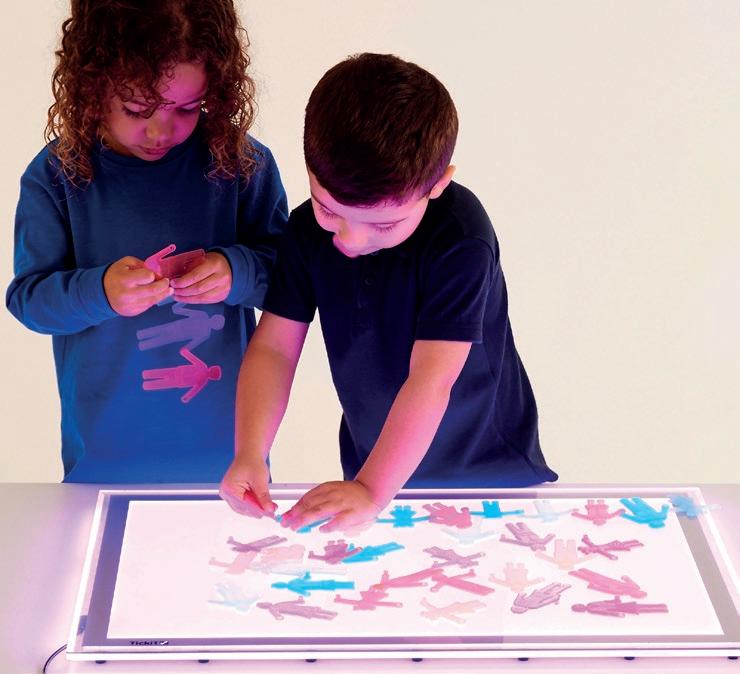
Product Code: 73018

Product Code: 73386
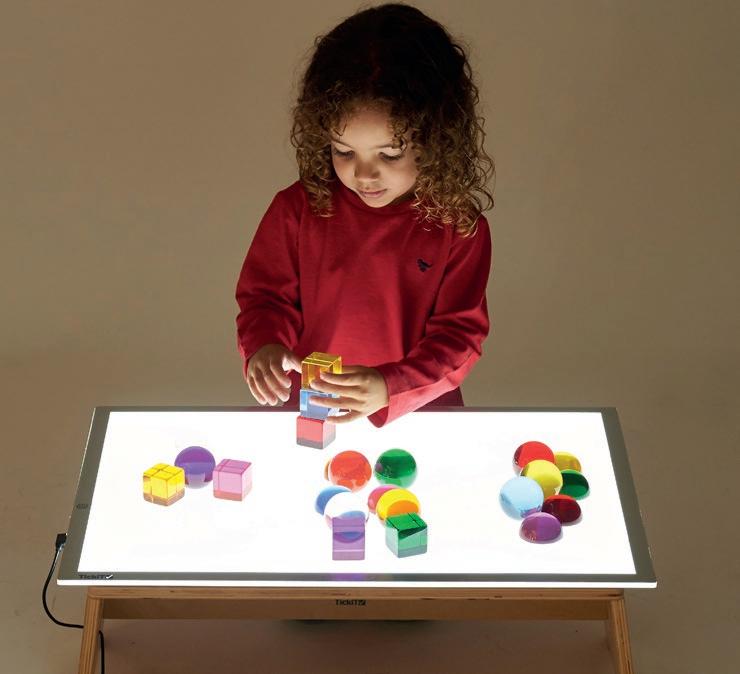
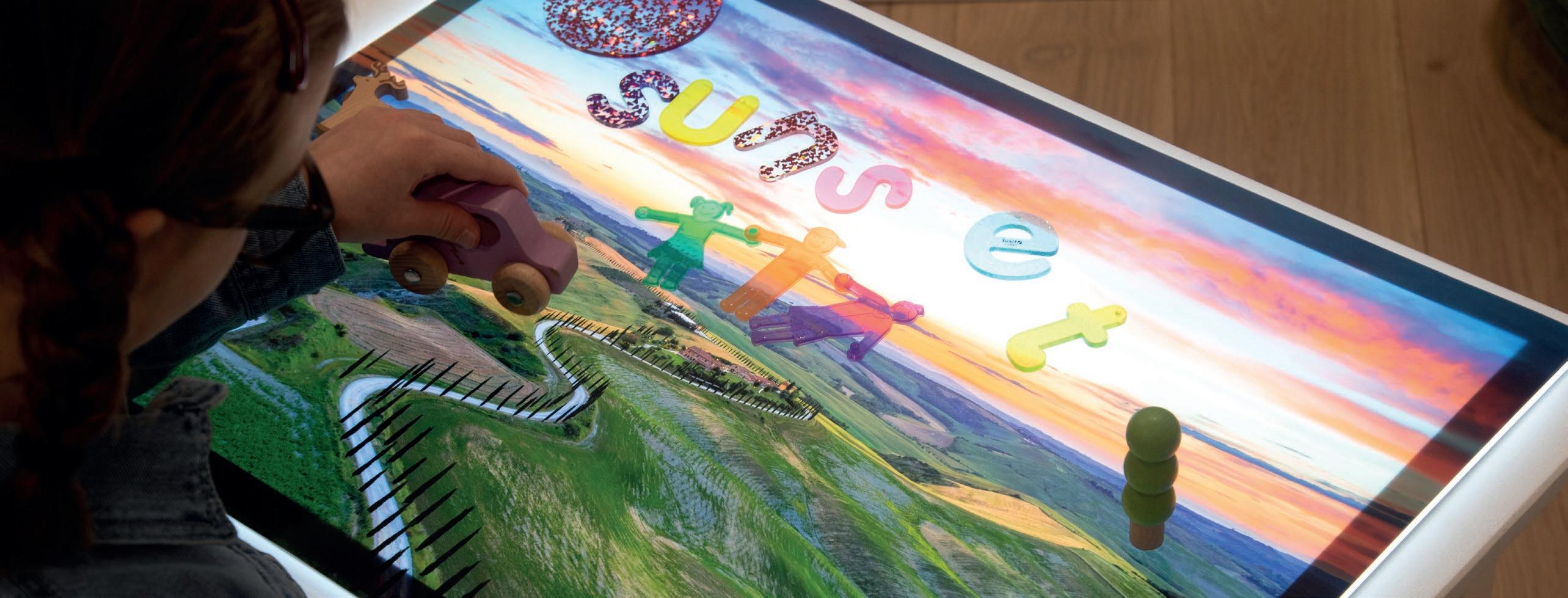
A2 Light Panel & Table Set
Product Code: 72271
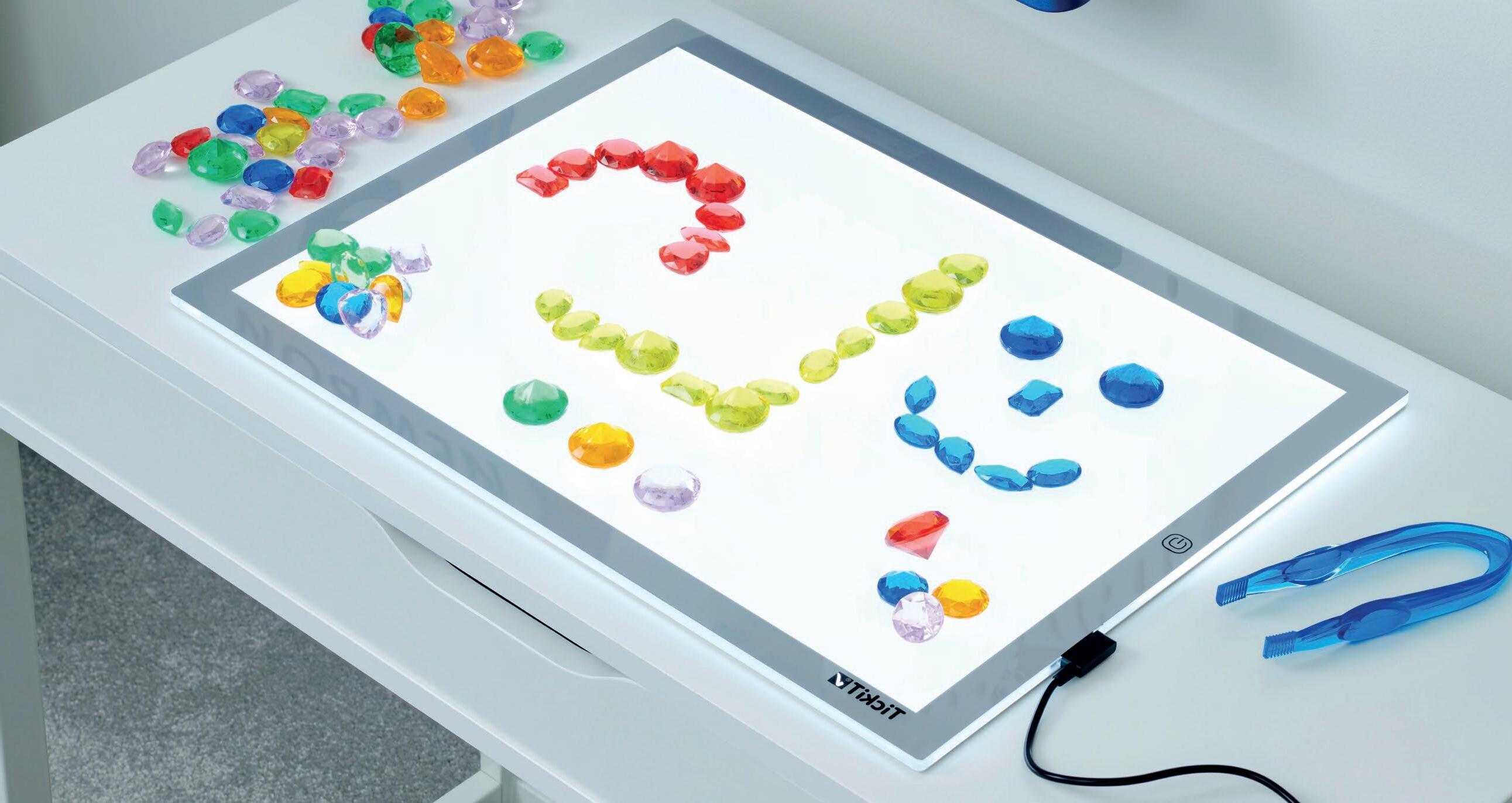
Light panels have now become a standard piece of equipment in most early years settings and primary classrooms. They enable the delivery of high quality learning but getting the most out of them requires imagination and careful planning.
Linda Thornton spent over 40 years working in the early years and primary sectors of education as a teacher, head teacher and education adviser focusing upon the ways in which young children learn and develop. Linda has drawn much of her inspiration from first-hand experience of the Reggio Emilia approach to early childhood where light plays a central part in the learning process. In this bullet-point guide she has listed 150 uses of a light panel covering all aspects of learning from observation of natural and man-made objects, colour mixing, creativity, scientific observation, mathematical perception, language development and more to give a flavour of just what is possible.
Not only do light panels provide the basis for exciting activities in the early years and primary stages but they can be used as a resource which enhances the quality of the learning environment - they provide an opportunity to create an atmosphere where quiet calm engagement is made possible.
The ideas outlined here should be thought of more as a starting point than an endgame… used properly light panels captivate children in their warm glow, enhance the learning process and provide illumination in the wider sense.

• Provide a variety of resources, such as Colour Paddles, SiliShapes, counters, natural and reclaimed materials. Used on a light panel, these will provide starting points for talking to children about colours, light, transparency, translucence and opacity.
• Use Colour Paddles on a light panel to help very young children identify a range of colours. You can add to this investigation by providing sheets of coloured acetate or tissue paper for young children to explore.
• Place the SiliShapes Sensory Circles on a light panel to see what happens when different colours are placed on top of one another or in overlapping patterns. Help the children develop their sensory awareness by encouraging them to trace the patterns on the large and small Sensory Circles using their fingertips.


• Use the Colour Paddles, the Splat set, coloured counters or acetate sheets to help children discover what happens when different colours are ‘mixed’ together.
• When they have begun to recognise what happens when particular colours are mixed together, encourage them to mix colours using paints on the clear tray on top of the light panel.
• Use coloured acetate or tissue paper to create ‘stained glass windows’ with the children. Very young children will enjoy exploring the effects of these windows on a light panel.
• Provide a range of different resources for the children to sort and classify by their characteristics - transparent, translucent or opaque.
• Help older children to look carefully at the range of colours around them. Show them ‘palettes of colour’ on a paint chart. Encourage them to find a range of greens, reds or blues in different resources and materials to place on a light panel and observe the effects.
• A light panel is the perfect way to explore the beauty of children’s paintings, especially if they have used water colours on thin paper. Choose a different child’s painting to display in this way for a day each week.
• Place a variety of objects on a light panel. Use the Perception Spheres and Perception Semispheres to


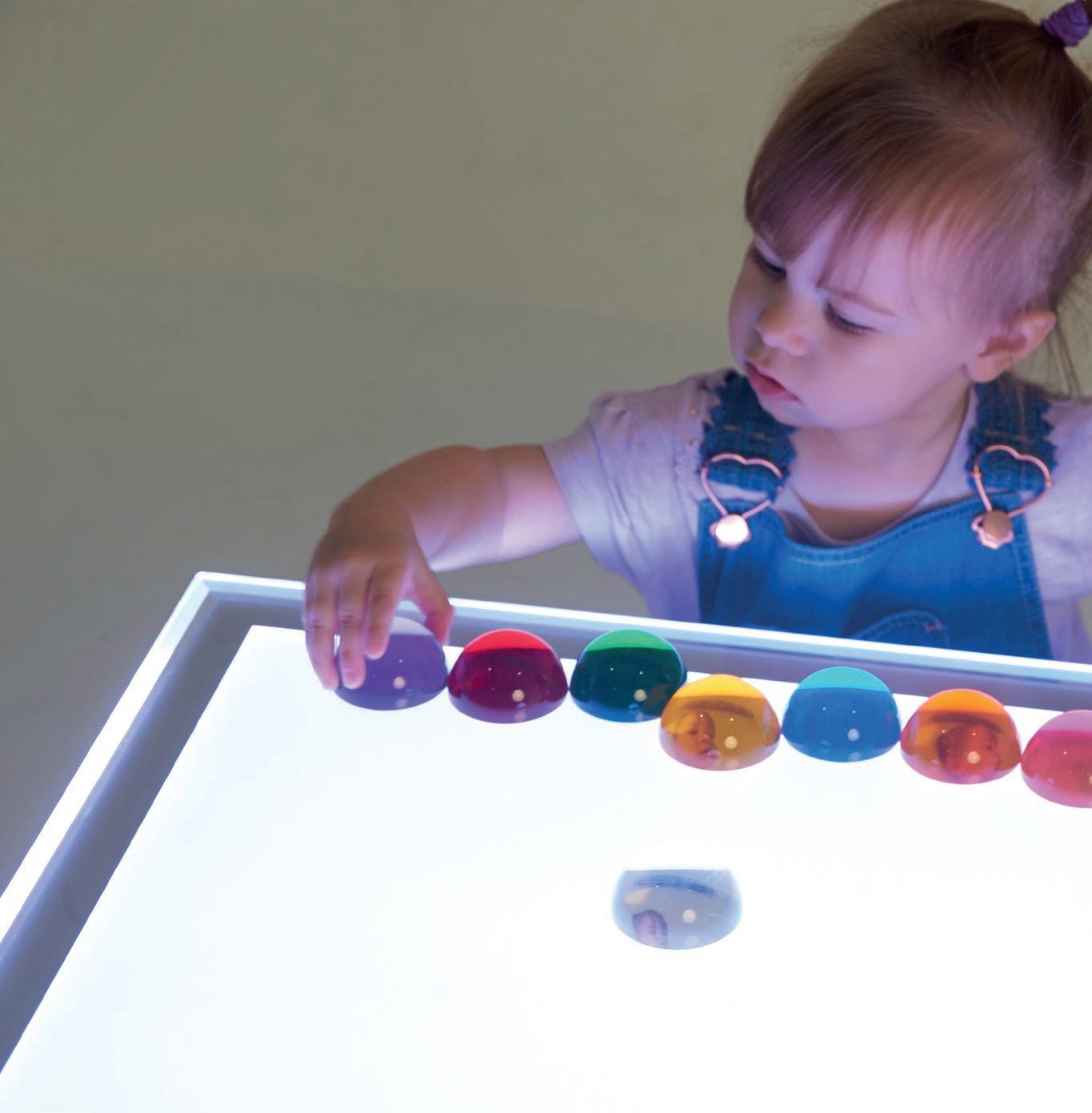

• Place the SiliShapes Linking People on a light panel and draw the children’s attention to the details of the characters. Show the children how to make rubbings of the various people to cut out and use on the light panel in their play.
• Make shapes from coloured acetate, use the Sensory Circles, Splats or Rainbow Blocks or provide natural and reclaimed materials and encourage children to look at the outlines and shapes of the larger objects.
• Go on to look at the detailed shapes of a range of objects. Place a variety of leaves on a light panel - include broad leafed, complex and simple leaves, evergreen and deciduous and encourage the children to look carefully and begin to sort and classify the types of leaves. Introduce Easy Hold Colour Panels and magnifying lenses for children to compare colours and look closely at the detail of the leaves.
• Extend the children’s exploration of the details found on leaves by looking at skeleton leaves on a light panel. Encourage children to look closely at the details and then introduce magnifying lenses so that they can look even more closely at the details.




• Human X-rays make fascinating viewing for young children who may have encountered them in hospital of at the doctor’s suragery.
• A visit to the dentist may result in children having a personal X-ray to explore using a light panel. Use alongside the Giant Teeth Demonstration Model to compare the layout of teeth and the X-rays.
• Children are fascinated by fingerprints and a light panel is the perfect resource for building on this interest. Use an ink pad to take the children’s fingerprints on thin paper. Put them onto the light panel and observe how they are all different using a magnifying lens. Look carefully at the arches, loops and whorls which make each fingerprint unique.
• A wide range of natural and reclaimed materials can be used to encourage children to look closely using a light panel. Try introducing seed and flower heads, ferns and feathers, paper doilies or lace - these are all interesting things to investigate. A snake skin would
Use the light panel to explore the details found on a variety of shells - the light source will give clarity not only to those shells which are translucent but will also encourage children to focus on opaque objects.
Compare translucent colour shells with real shells and shell X-rays to see the connections.
Provide good quality paper and drawing pencils for children to use on the light panel next to an object so that they can make careful close observational drawings. Providing clear acetate and fine pens for the close observational drawings will provide a further resource to use with the light panel.

• Use a variety of resources on a light panel to provide the opportunity to develop a ‘language of colour’ with children.
• By providing a rich variety of resources to use with a light panel which are transparent, translucent or opaque you can develop children’s scientific language in their everyday play.
• The SiliShapes Linking People will provide opportunities to develop children’s mathematical vocabulary - bigger/smaller, taller/shorter, older/younger, same as/different from.
• Using the SiliShapes Soft Bricks will provide further opportunities to develop mathematical language such as taller/longer/shorter, next to/on top of/underneath and below.
• Use translucent counters or shapes to talk about fewer/more/less, more than/less than, adding on/taking away, counting on, counting back.

• Using the Understanding Feelings Set will encourage children to express their feelings and emotions and develop the vocabulary they need to do this.


• When using the emotion faces on a light panel children will talk about what they are seeing and what they are doing. Work with them to develop their vocabulary and sense of story structure as they play.
• Take note of the stories children tell and the vocabulary they use when they play with the different SiliShapes Linking People. This will often be in relation to themselves and their own family lives, how they behave and how they feel.
• Creating beautiful pictures and patterns on a light panel and talking about what they have made to other children or adults will encourage children to extend their use of descriptive language.
• Using the Colour Crystal Block Set to create 2D and 3D models will provide opportunities for adults to interact and develop, and will extend children’s language for thinking.



• Create sets of upper and lower case letters using coloured acetate or use the Rainbow Letters on a light panel to help children recognise the letters of the alphabet.
• The SiliShapes Alphabet set can be used on a light panel for letter recognition, recognising initial sounds, reading simple words and spelling CVC (consonant, vowel, consonant) words.

• Adding the SiliShapes Trace Alphabet set will help children with correct letter formation. Use with additional sets for early word building and spelling.
• Use the Rainbow Letters and a collection of suitable resources for the children to match the initial letter sound to a real object. For example, ‘b’ and ‘button’, ‘c’ and ‘cone’, ‘sh’ and shell.

• Give each of the children a piece of clear acetate with their name printed on it in indelible ink. Children can use the name sheet on the light box to help them recognise their name, to label any pictures they have created on the light panel


Provide a clear tray with the base covered with coloured sand for children to use on the light panel to practise handwriting patterns, letter formation, writing their names and spelling words.

Children who do not particularly enjoy writing will often happily write on clear acetate on a light panel as they enjoy using the different medium.
• Create handwriting patterns and letters on clear acetate for the children to trace over.
• The same idea can be used for sounds and word groups in early phonics.
• Use the light panel and provide diagrams - such as the parts the body, the parts of a plant, life cycles - for the children to label. Copy the diagrams onto either clear acetate or thin paper for the children to use on the light panel which will give clarity to the lines of the diagram.
• Make available a wide range of resources, including natural and reclaimed materials for free play and storytelling using a light panel.
• Add small world characters and props to the range of resources next to the light panel to develop the children’s storytelling skills. Use sheets of coloured and clear acetate to help the children make backgrounds for their characters when they are telling stories.
• Use the SiliShapes Linking People to create stories with the children. Encourage them to invent stories of their own. Ask questions such as ‘Where do you think the Linking People might live?’ or ‘What do you think they enjoy doing?’
• Use a story character set to talk about characters - what they look like, how they behave and what they might say or do. Encourage the children to tell stories involving the characters. Give the children clear and coloured acetate or papers for them to make their own superhero and fairy tale characters to use on the light panel to create stories.
• Provide mirrors to add a further dimension to small world play and storytelling on a light panel. This works well with fantasy figures and environments.
• Take photos of the stories children create and record their



• Use clear acetate to create story strips, using words or words and pictures, for familiar stories and rhymes. Ask the children to put the story strips into the correct sequence on the light panel.
• Give the children clear acetate and permanent markers and ask them to develop a story, in pictures or words, which they can share with others using the light panel.

• Using a range of resources on a light panel is a perfect way of interesting children in counting and numbers. Using brightly coloured translucent resources on a light panel is an attractive and compelling activity and children will delight in learning to count using them.
• Use counters or pattern blocks to pose questions which encourage children to count and problem solve. For example, ‘Can you find me three red triangles?’ or ‘Can you put four blue rectangles on the light panel?’
• Try using a variety of buttons on the light panel. Choose different sizes, shapes, colours and with a varying number of holes. Counting both the buttons themselves, as well as the number of holes they have, can lead children to set and solve a wide range of mathematical problems.

• Use larger quantities of counters or beads on the light panel for children to experience counting larger numbers of objects and understanding place value.
• Provide opportunities for children to use numbers and objects on the light panel so that they can experiment with a number of objects, the appropriate numeral and the written number word.
• The SiliShapes Numbers sets are perfect for use on a light panel to support number recognition, ordering numbers, counting and labelling. The Dot Numbers set can be used alongside to encourage counting the dots and matching the quantities of dots to the appropriate numbers.
• The SiliShapes Trace Numbers set will help children with developing correct number formation. Use both sets together to solve mathematical problems.

• Use the SiliShapes Linking People to encourage children to count, sort and order the characters. Talk to the children about the different attributes and relationships of the family members and pose problems for them to solve.
• Make signs - addition, subtraction, multiplication, division, equals, more than, less than - out of coloured acetate for the children to use with Rainbow Numbers or SiliShapes Numbers on the light panel. Encourage them to work in pairs, setting problems for each other to solve.
• Provide squared acetate sheets and water based pens for the children to colour various number patterns. The acetate sheets can then be wiped clean for future use. This would also work for making number staircases.


• Make four piece ‘jigsaws’ using sheets of coloured acetate for young children to explore and fit together. Older children will enjoy using the Translucent Geometric Shapes to discover the geometric properties of 3D shapes.
• Use coloured acetate to create large shapes or use the Jumbo Colour Mixing Shapes for the youngest children to identify and name different shapes using a light panel. Older children can use smaller shapes, such as Translucent Attribute Shape Set, to learn about more complex shapes and to see how they fit together or they can be used to create patterns.
• Use a selection of translucent shapes to encourage children to copy existing patterns, complete a sequence or create patterns of their own.
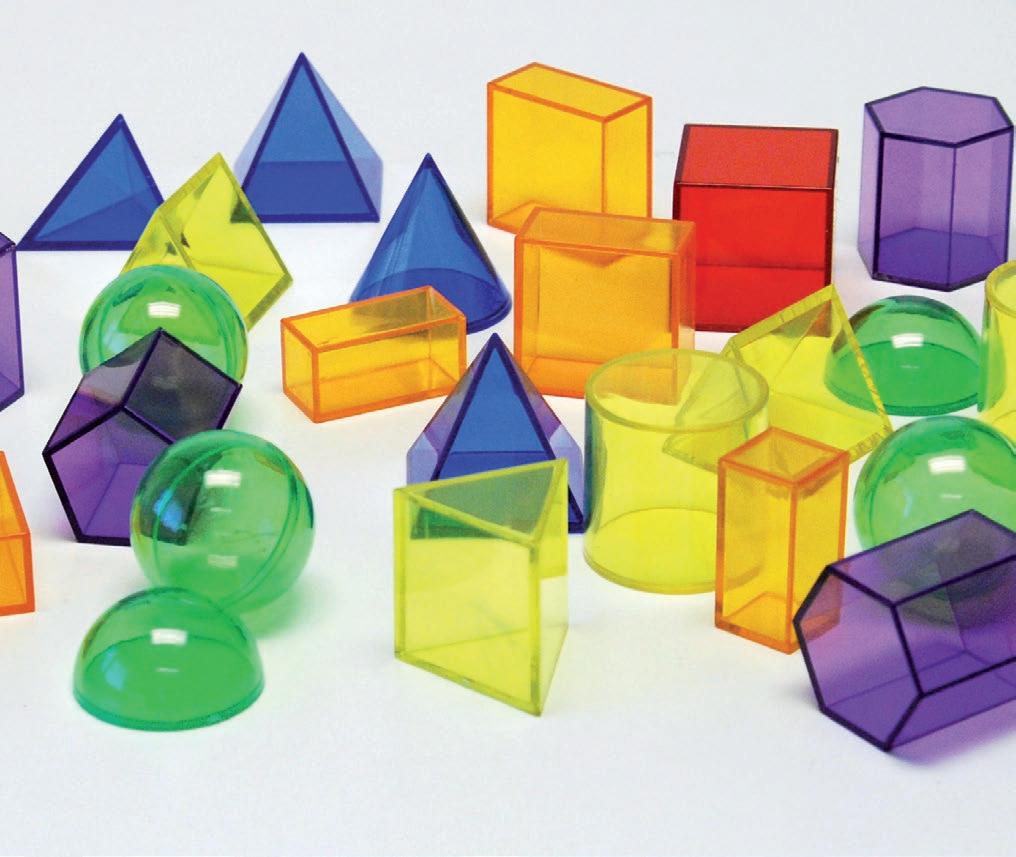
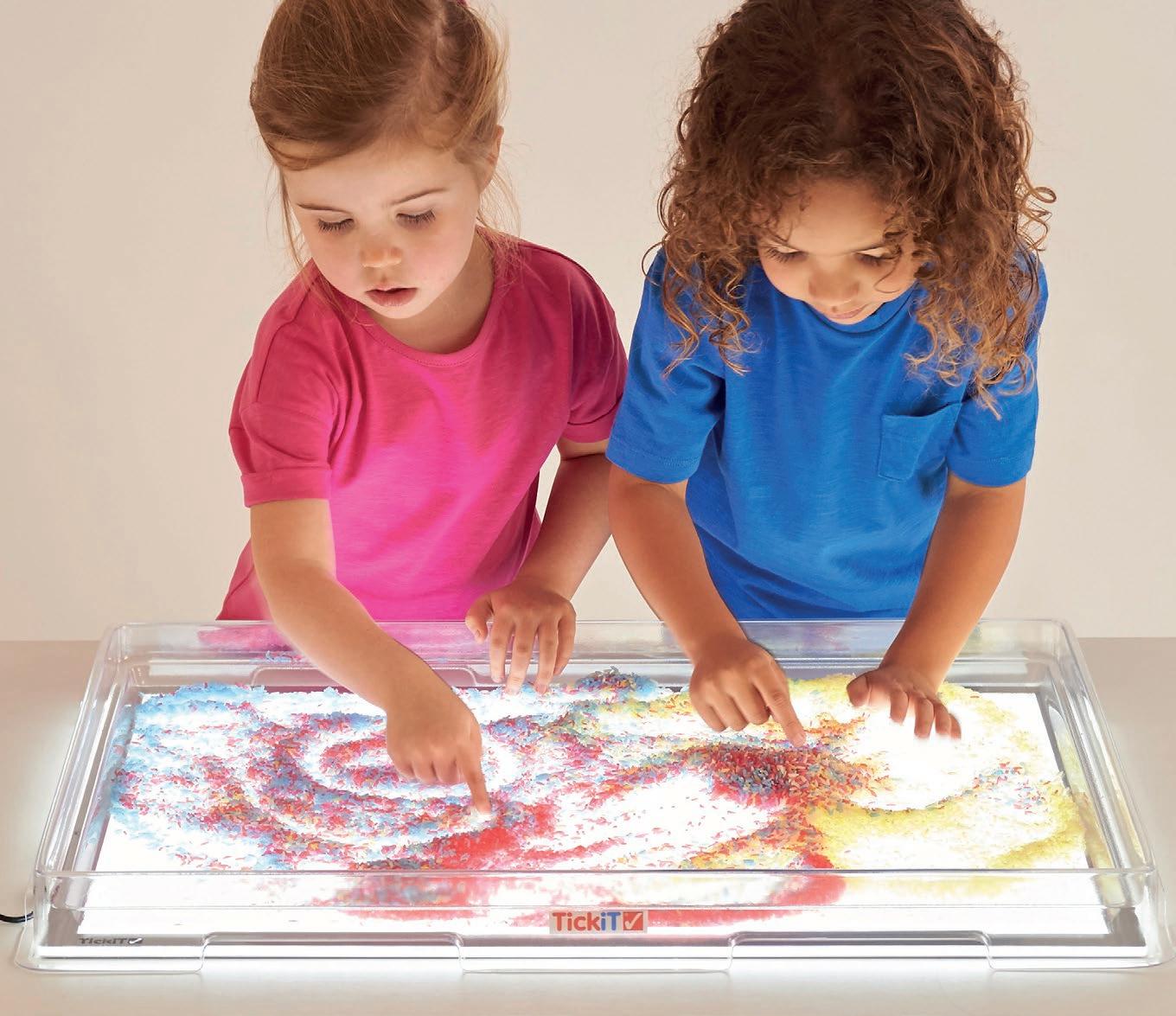
• Create patterns, both vertical and horizontal, for children to copy by stacking the SiliShapes Soft Bricks or placing them horizontally in different formations.
• Use the SiliShapes Linking People on a light panel to create different repeating patterns. Try arranging the characters in different ways - in a horizontal line, in a circle, in a square or pyramid.
• Use reclaimed materials of different 2D and 3D shapes for the children to explore freely on the light panel. Use a variety of transparent, translucent and opaque objects. Suggest that the children might use the resources to create patterns.

• Use clear or translucent geo-boards and coloured elastic bands with the light panel so that children can explore the outlines, edges and corners of shapes. The light panel will create a focus on identifying 2D shapes by their characteristics.
• Using a clear desktop tray and coloured sand, encourage children of all ages to ‘draw’ shapes. Have them work in twos, giving each other instructions about which shapes to draw in the sand.
• Use the pattern blocks and tangram sets to help children discover how shapes tessellate.
• Have fun ‘taking a line for a walk’ using a black water based pen on clear acetate. Ask the children to include particular shapes in their ‘walk’. They will enjoy colouring the regular and irregular shapes which are created. Try leaving the regular shapes clear and encourage the children to label these shapes on the acetate.


• Providing a collection of the Perception Spheres in a basket for young children to explore will encourage them to explore the world around them using their senses. They will enjoy touching and handling the balls and will see the world in different colours as they look through the spheres in turn at objects placed on a light panel.
• Explore early mark making by encouraging children to try finger painting on a clear tray on the top of the light panel. The thick paint marks and the light from below will create interesting effects.
• Place a clear tray on top of the light panel and arrange curved ‘waves’ of different coloured pulses and grains - orange and green lentils, pearl barley, different types of rice - and watch how the children explore line and pattern making with their fingers and hands.
• Use a clear cantilevered artist’s box to display translucent, transparent and opaque objects. Buttons, beads, shapes, glass nuggets, stones, shells, small bottles and papers can all be provided to encourage children to develop their creativity through exploring the things of beauty on a light panel.
• Use a jewellery box to display a collection of pieces of jewellery which are no longer used next to a light panel. Children will find many different creative ways to explore, investigate and arrange the items of jewellery.

• Develop children’s artistic and creative skills by encouraging them to paint with inks on thin paper on a clear tray on top of the light panel. Painting flowers or other detailed natural materials will encourage them to look closely and pay attention to detail.
• Playing with painted paper faces on a light panel will pose challenging problems for young children as they create and name real and imaginary characters.

• The addition of a mirror to a light panel will help develop children’s creative thinking skills as they see the resources they are using from different angles.
• Collect together a wide range of bottle tops and other reclaimed plastic materials and arrange them in a reclaimed cardboard box in palettes of colour. Observe how individual children choose to use the reclaimed materials on the light panel in many different creative ways.
• Using the set of Perception Semispheres with a range of small objects on a light panel will encourage children to think creatively. The brightly coloured transparent semispheres can be placed over the


opaque objects. Suggest that the children might use the resources to create pictures.
• Use the same activity for imaginative picture making using natural materials or a combination of natural and reclaimed materials.
• Place a tray of coloured sand on a light panel and encourage the children to become involved in picture making using their fingers to draw with.
• Add brushes, rollers and shape stampers to extend picture making using a tray of sand on a light panel.
• Use the Colour Crystal Block Set for children to create pictures on a light panel, either following a diagram or by creating their own ideas.
• Help children create symmetrical butterfly pictures using coloured shapes and a mirror on a light panel.

• Try the activity above using a mirror with a tray of sand. Encourage the children to create other symmetrical pictures and patterns.
• Provide a wide range of colourful resources and materials for the children to use on a light panel. Show them a range of work by different artists and ask them to create a picture inspired by the great artists. Take photographs of the results to display alongside the work of the artists.
• Ask the children to work in pairs using the light panel. Place a barrier across the middle of the light panel. An adult should then describe a picture, one aspect at a time, which they want the children to create using the resources provided. When the children have finished remove the barrier and compare what the children have created. This activity can be extended to have one child describe a picture which they want a second child to create on the light





• Take photographs of the structures children have built, or a selection which you have built yourself, and ask the children to re-create these buildings on the light panel, following the originals exactly.
• Place a barrier between yourself and a child working on a light panel and describe a structure you want the child to build - step by step. See how well they follow your instructions.
• Using a mirror across the centre of the light panel, ask individual children to build a symmetrical structure. Talk to them about what they can see and why it has happened.
• Repeat the previous activity with a pair of children working together to create the structure you are describing. Observe how well they work as a team to follow your instructions.
• Provide a variety of translucent, transparent and opaque reclaimed objects on a light panel for the children to build with - clear food containers, boxes, small bottles and reels will work well.
• Position a range of small world play characters next to a light panel and suggest to the children that they use the SiliShapes Soft Bricks to build castles, houses, ships or other structures to use in their small world play.
• Use the SiliShapes Soft Bricks to encourage children to observe what happens when different colours are built up on top of one another on a light panel, talking about shades and tones of colour.
• The activity above can be extended by the addition of the Rainbow Block Set, the Sensory


learn how to create more complex stable structures.
• With older children use clear and coloured acetate to create the nets of 3D shapes. Help them to create the 3D shapes to use to build structures on a light panel.

• Extend the pattern making activity by asking the children to model patterns found in nature - spirals on shells, lines on leaves, spiders’ webs. Show them the real things or good quality photographs.
• Encourage early mark making and picture making by providing children with ‘waves’ of coloured sand on a clear tray on the light panel.
• Use different colours of sand in clear trays on a light panel for children to make patterns using their fingers, hands, rollers or brushes.
• Put a clear tray with natural coloured sand in it on top of the light panel alongside shells, stones, small pieces of driftwood, small world play pirates to add a different dimension to the children’s imaginary play. Help them to draw maps in the sand or create a hilly, rocky landscape.


• Place the Exploration Light Tray on top of a light panel and half fill it with water. Provide model fresh water and sea creatures, small boats, large pebbles and shells for small world play.
• Have fun with mathematical investigations by placing a clear tray of water on the light panel and use tropical fish counters or sea creatures for counting, addition and subtraction investigations. The children could make fish from coloured acetate.
• Put a tray of coloured or clear bubble mixture on top of a light panel and ask the children to blow bubbles. Using the light panel means that they can look closely at the details of the bubbles.
• Use this absorbent paper to make a print of the bubbles by placing the sheet of paper gently on to the surface of the bubbles. Remove the tray and put the print of the bubbles on to the light panel and look at the result closely. Perhaps the bubble prints can be turned into pictures?
• Fill the Exploration Light Tray with water and place onto a light panel, then add a few drops of marbling inks. Look closely at the effects which will be very clear as the light shines through. Use thin absorbent paper to capture the marbling patterns.
• Make up a tray of coloured ice cubes in advance. Place a tray of water on the top of the light panel and gently put the ice cubes into the water. Watch what happens when the ice cubes melt. Take photos of the process for the




• Place a clear tray on top of a light panel and drop different food colouring liquids onto it using a dropper or pipette. Look carefully at the results.
• Encourage children to observe what happens if the food colouring is dropped from a higher or lower position.
• Try dropping food colouring or thin paint onto thin absorbent paper and observe what happens.
• Dampen a sheet of filter paper, chromatography paper or another absorbent paper with water and place onto a clear tray on top of the light panel. Drop individual food colours onto the paper and look closely at how the different colours behave.
• Use a dropper with inks, food colourings or thin paint and make drips and dribbles onto a clear tray on the light panel. Turn the drips and dribbles into pictures and patterns using brushes or fingers. Take photos of the pictures or make prints.

• Make drips and drops of paint or inks onto a clear tray on the light panel and blow them into patterns using a drinking straw. Make prints of the patterns.
• Place a clear tray on top of the light panel. Make ‘splatters’ onto the tray by running a ruler along the head of a toothbrush which has been filled with paint. Look closely at the patterns which have been created.





• Place cardboard or plastic shapes onto a clear tray on top of the light panel and create ‘splatters’ around the shapes by running a ruler along the head of a toothbrush which has been filled with paint. Encourage children to make their own shapes to use in this activity. Repeat the activity above using the Colour Crystal Block Set to create patterns and pictures.
• Use a selection from the Sensory Liquid Sets on a light panel to observe in detail how liquids flow.
• Fill clear beakers or small bottles with water and place on top of the light panel. You may wish to place them on top of a clear panel in case of spillages. Drop individual food colourings into the water, a few drops at a time. The light will allow children to see clearly how the different colours disperse in the water.
• Photocopy black and white patterns onto clear acetate for babies and toddlers to explore using a light panel.
• Using a light panel with very young children will engage their attention and encourage them to look closely at different objects. Babies and young children will be fascinated by seeing black and white shapes and objects in relief- use black and white shapes, circles, rings and reclaimed objects.
• Use a clear tray on top of a light panel and add black and white paint for early mark making and for creating patterns and pictures.
• Provide a collection of black and white buttons for pattern making on a light panel.
• Extend the activity above by looking carefully at the different shades of grey created by mixing small amounts of the white to the black or vice versa.

• Use thin white and black paint on a clear tray on a light panel for blowing and printing and ‘splatter’ painting.
• Set up a display of shells, flowers, small world play characters and ask the children to make close observational drawings on thin paper, tracing paper or clear acetate on the light panel. Provide black pens, pencils, pastels and charcoal. Look closely at the details.
• Provide white and black papers, fabrics, lace, buttons, beads for placing and arranging on a light panel. Take photographs of the children’s transient art.



• Place some iron filings in a sealed, clear plastic container and place on top of a light panel. Using a magnet create patterns and pictures in the tray of iron filings.
• Use black and white natural and reclaimed materials for placing and arranging- for example, black stones, mussel shells, white pebbles, white shells, beads, glass,
• Provide a range of natural materials including stones, shells, leaves and twigs to explore on a light panel.
• Encourage them to look at the details of the natural materials and to classify them into those which are translucent, transparent or opaque.
• Create a ‘Naturals Box’ collection for children use for placing and arranging- storytelling and imaginative picture making.
• Use a light panel for children to look closely at the details of the spirals they find in nature particularly in shells, snail shells and fossils. Provide clear acetate for close observational drawing of the spirals and tissue paper for cutting out spirals to put on the light panel.
• Collect seed pods and cones and place them on a light panel so that they can be seen clearly. Provide photographs of the pods and cones for the children to compare with the real thing.



• Place a sheet of thin paper on the light panel and create prints using thin paper, twigs or by rolling cones covered in paint. Look closely at the patterns created.
• Provide a selection of flowers, insects, aconites and other naturals which have been preserved in acrylic blocks so that children can observe their details. Encourage them to make close observational drawings of what they see.
• Ask the children to draw the outlines of flowers and other natural materials onto clear acetate. Place the drawings onto an overhead projector and project the images onto large sheets of paper, fabric or clear plastic for the children to trace over and colour to make large scale banners.
• When children are exploring spiders’ webs draw their attention to what they look like in detail. Recreate webs on a light panel using threads or wool using stones or plastic ‘jewels’ as drops of dew. Encourage children to draw webs on clear acetate on the light panel and then add decoration or a spider they have created.
• Use the light panel to look at ‘How green is green?’ By looking at leaves of different shades of green on a light panel children will observe the different shades and tones of the colours of leaves. Provide Colour Paddles alongside for colour mixing and paint charts to compare the different shades of green.


• Provide a range of reclaimed materials such as lids, bottle tops and reels for children to explore 2D and 3D shapes using a light panel.
• Collect small clear bottles and help the children to add different contents which they have chosen to explore as they play with them on a light panel.
• A basket filled with used perfume bottles of different sizes and shapes will be interesting for children to explore on a light panel.
• Half fill small bottles or lidded containers with different coloured liquids and watch the effects of the light on the bottles as they are carefully moved about.
• Help the children to take to pieces old clocks or other small appliances and use a box to display the individual cogs, gears, screws and other parts for the children to explore on the light panel.
• Make a ‘Jewellery Box’ collection of unwanted pieces of jewellery for children to look at closely on a light box. Encourage them to observe the effects of light on different materials.

• Encourage children to see the beauty in reclaimed metal objects and to use them in picture and pattern making on a light panel.
• This activity can be repeated using a collection of Christmas tree decorations. Take photographs of the children’s arrangements using the different decorations and turn them into Christmas cards or cards for other festivals and celebrations.

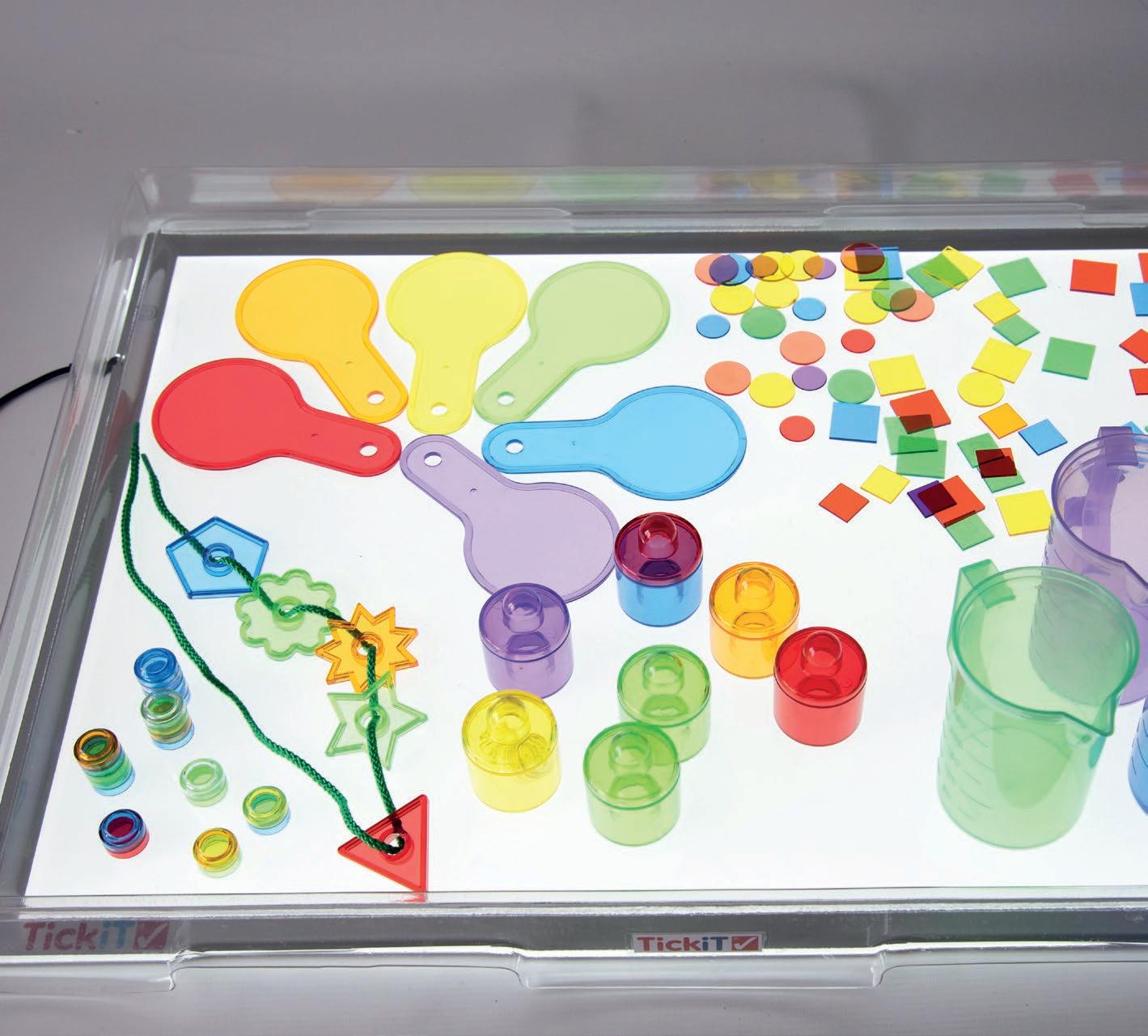
• Look at a selection of fabrics and net, mesh and lace on the light panel to observe the pattern details. Encourage the children to talk about, and describe, the details of the reclaimed materials and to make patterns and pictures from the materials.
• Use recycled wrapping paper, tissue, sweet wrappers and cellophane from bunches of flowers to create pictures on a light panel.


Gem Cubes
Product Code: 73548, 73550, 73586


Rainbow Letters & Numbers
Product Code: 72433, 72431

Translucent Colour Bugs
Product Code: 73199

SiliShapes® Linking People
Product Code: 54513


Splats
Product Code: 72397

Sensory Glitter Storm Set
Product Code: 92104

Perception Semispheres
Product Code: 72602

Rainbow Blocks Product Code: 73275

Rainbow Glitter Shapes Product Code: 72622

SiliShapes® Sensory Circles
Product Code: 54517

Colour Crystal Block Set
Product Code: 72606

Easy Hold Colour Panels
Product Code: 73359

Home of educational play
tickit® is owned by Commotion Ltd. www.tickit.co.uk I www.tickit.eu I www.commotion.co.uk
Commotion Ltd, Commotion House, Tonbridge, Kent TN9 1RA, UK Commotion (Europe) BV, Schiphol Boulevard 359, 1118BJ Schiphol, NL